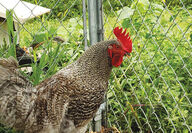Sorted by date Results 78 - 102 of 186

Grazing corn stalks is one way for farmers and ranchers to reduce the cost of wintering beef cows. However, "grazing corn stalks" is a bit misleading, as cattle shouldn't be forced to graze the stalk of the corn plant, say North Dakota State University Extension specialists. "The components of the corn plant remaining postharvest include the stalk, leaf, husk, cob and any downed ears," says Zac Carlson, NDSU Extension beef cattle specialist. "The components with the greatest nutritive value are...

Row crop harvest is in full swing across North Dakota, with many crops near harvest completion. Weather conditions have been warm and dry, allowing producers to harvest crops without the pressure to get the grains harvested before winter arrives. However, dry and warm conditions increase the risk of combine fires, especially when harvesting sunflowers. In 2022, North Dakota saw a huge increase in planted sunflower acres, with the National Agricultural Statistics Service (NASS) stating that oil...

Warm, dry weather can result in soybeans being too dry at harvest. "The soybeans lose weight and become brittle, increasing the potential for handling damage when they are too dry," North Dakota State University Extension agricultural engineer Ken Hellevang says. "Also, producers lose money at lower moisture contents." Farmers may want to condition soybeans that were harvested at lower moisture contents to bring the moisture content up to the market standard of 13%. On a 40 bushel-per-acre...

Harvested forages are a critical component of winter feeding programs for many of North Dakota's cattle herds. "Conducting a hay inventory now will give producers a good idea of possible deficiencies and allow time to develop the best options for the upcoming feeding season," says Janna Block, North Dakota State University Extension livestock systems specialist based at the Hettinger Research Extension Center. The first step is to get an accurate count or measurement of bales harvested. Bales...

The North Dakota Lamb and Wool Producers Association will host their annual convention on Friday, Oct. 7 and Saturday, Oct. 8 at the Roughrider Hotel, Medora. On Friday, the event starts with golfing at the Bully Pulpit at 10 a.m. The speed shearing contest beginning at 5 p.m. will feature shearers and provide unique entertainment for the crowd. Events will continue as attendees return to the Roughrider Hotel. The American Lamb social sponsored by Double J Lamb begins at 6:30 p.m. and will...

With a recent positive case of highly pathogenic avian influenza (HPAI) in North Dakota, North Dakota State University Extension specialists continue to encourage biosecurity practices for bird owners of all sizes and around wild birds. "While we hoped there would not be a resurgence of HPAI this fall, we knew this was a possibility," says Gerald Stokka, NDSU Extension veterinarian and livestock stewardship specialist. "We encourage poultry owners of all sizes to continue biosecurity measures...

Moisture content of forage at baling has a direct impact on bale heating and subsequent forage nutrient content at feeding, says North Dakota State University Extension forage crops production specialist James Rogers. "Managing moisture content of forage at baling this year was a challenge," says Rogers. "For many it seemed that at the point hay was dry enough to bale, a rain shower would delay baling." Controlling moisture at baling can reduce damage to the hay by microorganisms. "Just like...
“There is increased interest in planting winter wheat this year and for good reason,” says Clair Keene, North Dakota State University (NDSU) Extension agronomist. “With many prevent plant acres in the state, good soil moisture heading into the end of the growing season, severe drought in much of the Southern Plains and higher wheat prices than we’ve been accustomed to the last few years, 2022 is shaping up to be favorable for growing winter wheat,” says Keene. In addition to the positive market conditions, some other benefits of planting...

U.S. Sen. John Hoeven announced a federal appropriation that will develop a partnership between North Dakota State University, the U.S. Department of Agriculture Agricultural Research Service and Grand Farm around research development and educational opportunities in agriculture technology. This announcement occurred at an event held at NDSU. "Grand Farm is about leveraging North Dakota's global leadership in agriculture and the dynamic technology sector that we've built in our state to develop...

North Dakota State University's soybean breeding program conducts research every growing season on the tolerance of soybean varieties to iron deficiency chlorosis (IDC). "If farmers had IDC in their fields this year, they should consider using the NDSU tolerance ratings generated in 2022 and previous years, to select soybean varieties for 2023, to minimize the chlorosis in their fields," says Hans Kandel, NDSU Extension agronomist. During the summer of 2022, NDSU's soybean breeding program...

"There is increased interest in planting winter wheat this year and for good reason," says Clair Keene, North Dakota State University (NDSU) Extension agronomist. "With many prevent plant acres in the state, good soil moisture heading into the end of the growing season, severe drought in much of the Southern Plains and higher wheat prices than we've been accustomed to the last few years, 2022 is shaping up to be favorable for growing winter wheat," says Keene. In addition to the positive market...

Field Days at North Dakota State University's Williston Research Extension Center (WREC) are set for July 13 and 14. The annual dryland agronomy and horticulture field day will be held Wednesday, July 13, at the center, which is 4.5 miles west of Williston on U.S. Highway 2. The event begins with registration at 3 p.m. Central time. The dryland crops tour starts at 4 p.m. NDSU research scientists will highlight their work. NDSU President, David Cook, and Greg Lardy, NDSU vice president for...

Weather conditions this spring and summer and much needed rainfall have lifted North Dakota out of drought conditions. Temperatures have been mild with a lot of cloudy and overcast days. These conditions have been great for forage growth, but they have been less than ideal for hay drying and curing, says James Rogers, North Dakota State University (NDSU) Extension forage crop production specialist at the North Central Research Extension Center, Minot. "Over the past few weeks, hay harvesting...

Extreme temperatures are expected to hit many parts of North Dakota this week, increasing the potential for heat stress in cattle, warns Karl Hoppe, North Dakota State University livestock systems specialist. "One day of heat stress is uncomfortable, but two or more days back to back without night cooling can be deadly for livestock," says Hoppe. "Signs that animals are trying to regulate their internal body temperature include an increased respiration rate, increased heart rate and increased...

Highly pathogenic avian influenza (HPAI) was confirmed in a wild snow goose in North Dakota on March 24 and in a non-commercial, backyard chicken flock in Kidder County. The North Dakota Game and Fish Department sampled a wild bird mortality in Burleigh County that was confirmed positive by the National Veterinary Services Laboratory in Ames, IA. Samples from the North Dakota flock were tested at the North Dakota State University (NDSU) Veterinary Diagnostic Laboratory and confirmed by the...
Currently 36% of North Dakota is experiencing some level of drought as drought conditions continue to persist in the western part of the state. “Drought impacts are at the forefront of many rancher’s minds as we head into the 2022 grazing season,” says Miranda Meehan, North Dakota State University (NDSU) Extension livestock environmental stewardship specialist. “Concerns linger about long-term impacts of the drought on forage production as well as the risk of a continued drought throughout the year.” NDSU specialists will be hosting live webi...

Access to adequate, good quality water will continue to be a challenge for ranchers in North Dakota this spring, according to North Dakota State University (NDSU) Extension livestock environmental stewardship specialist, Miranda Meehan. Many ranchers in the region still depend on surface water sources, such as dugouts and stock dams to provide water to grazing livestock. Due to drought conditions in both 2020 and 2021, many livestock sources either dried up or were potentially toxic to livestock...

Planning for the future can be a very frustrating process especially in times of market volatility. Planning typically pays high dividends. For most farm and ranch managers, developing realistic commodity price expectations is one of the most difficult and complex tasks of the planning process. To make the planning process easier, North Dakota State University (NDSU) Extension has released its 2022 short- and long-term agricultural planning price projections for North Dakota, says Ron Haugen,...

Farmers can elect coverage and enroll in crop-by-crop Agricultural Risk Coverage-County (ARC-CO) or Price Loss Coverage (PLC) programs within each Farm Service Agency (FSA) farm unit, or ARC-Individual for the entire farm, for the 2022 crop year, says Ron Haugen, North Dakota State University (NDSU) Extension farm management specialist. Although election changes for 2022 are optional, enrollment by signed contract is required for each year of the program. This is an annual decision that farmers...

Farmers will have the opportunity to learn more about the upcoming Agriculture Risk Coverage (ARC) and Price Loss Coverage (PLC) election and the decisions the programs entail during a webinar that North Dakota State University (NDSU) Extension and the North Dakota Farm Service Agency (FSA) are hosting on Thursday, Feb. 3, at 11 a.m. CST. The webinar will also include information on FSA's Noninsured Crop Disaster Assistance Program (NAP). The ARC and PLC sign-up period runs through March 15...

The success, dedication and hard work of outstanding agriculturists in 53 counties in North Dakota and 10 counties in Minnesota were honored during the 47th annual Harvest Bowl program at North Dakota State University on Nov. 19. Information on the outstanding agriculturists listed by county is available at https://bit.ly/2021HBCountyBios, and photos are available at https://bit.ly/2021HBHonoreePhotos. 2021 Harvest Bowl honorees by county, name and city: Adams - Jamie and Nikki Enerson,...

North Dakota State University (NDSU) Extension again will host the Field to Fork "Wednesday Webinar" series starting in February 2022. Experts from across the region will provide information about growing, preserving and preparing specialty-crop fruits and vegetables safely in this seventh annual webinar series that has reached thousands of people The "Field to Fork Wednesday Weekly Webinars" will begin Feb. 16. The webinars will be held online from 2-3 p.m. Central time through April 20. They a...

Farmers can elect coverage and enroll in crop-by-crop Agricultural Risk Coverage-County (ARC-CO) or Price Loss Coverage (PLC) programs within each Farm Service Agency (FSA) farm unit, or ARC-Individual for the entire farm, for the 2022 crop year, says Ron Haugen, North Dakota State University (NDSU) Extension farm management specialist. Although election changes for 2022 are optional, enrollment by signed contract is required for each year of the program. This is an annual decision that farmers...

The 52nd annual Sugarbeet Research Reporting Session will be held on Tuesday, Jan. 11, at the West Fargo Convention Center starting at 7:30 a.m. Researchers and Extension specialists from North Dakota State University (NDSU), the University of Minnesota, the U.S. Department of Agriculture, as well as from European research institutes and universities will provide updates on current sugarbeet research. "Each year the Sugarbeet Research and Education Board of Minnesota and North Dakota provides ge...

Drought brings many nutritional and animal health-related challenges. Cow performance issues during the grazing season may result from reduced forage quality and quantity. It is possible that cows will enter the fall and winter in lower than desired body condition score and with other potential nutrient deficiencies that may not be noticeable. Vitamin A deficiency is one potential challenge that may arise when feeding drought-affected forages, according to North Dakota State University (NDSU)...